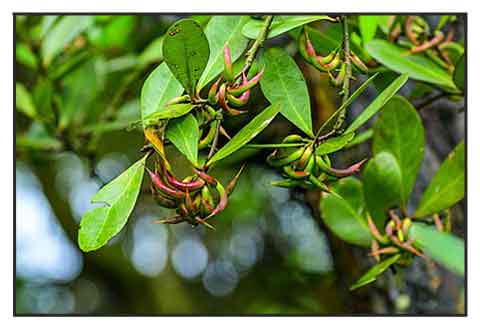 Gen info Gen info
- Aegiceras is a genus of trees occurring as mangroves in coastal or estuarine areas.
- The genus was first described in 1788 by Joseph Gaertner.
- Etymology: The genus name derives from two Greek words: "aix" meaning 'goat' and "keras" meaning 'horn', referring to fruits having horns like a goat. The species is Latin "corniculatus", meaning curved like a horn, referring to the shape of the curved fruits of this species. (2)
- There are two species accepted by Plants of World Online: Aegiceras floridum and A. corniculatum.
Botany
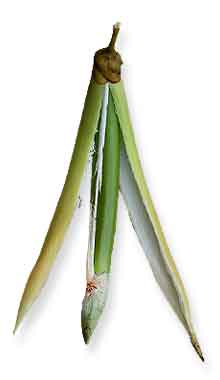 • Aegiceras corniculatum is a tree growing up to 6 m tall, with multiple stems. Bark is smooth, grayish with lenticels and roots that run along the soil surface. Leaves are spirally arranged, short-stalked. Leaf blades are leathery, drop-shaped or oval with smooth margins, green above, brownish-green below, 3-10 cm by 1.8-4.5 cm. Leaves are often encrusted with salt crystals that are secreted through the glands on the leaf blade. Flowers are small, sweetly fragrant, 1-2 cm long, borne in clusters at the leaf axils, with five white petals, reflexed backwards at maturity. Fruits are one-seeded cylindrical capsules, curved and pointed at the tip, light green to purple when ripe, 3.8-8 by 0.4-0.6 cm. Seed germinates within the fruit while attached to the parent tree. (1) • Aegiceras corniculatum is a tree growing up to 6 m tall, with multiple stems. Bark is smooth, grayish with lenticels and roots that run along the soil surface. Leaves are spirally arranged, short-stalked. Leaf blades are leathery, drop-shaped or oval with smooth margins, green above, brownish-green below, 3-10 cm by 1.8-4.5 cm. Leaves are often encrusted with salt crystals that are secreted through the glands on the leaf blade. Flowers are small, sweetly fragrant, 1-2 cm long, borne in clusters at the leaf axils, with five white petals, reflexed backwards at maturity. Fruits are one-seeded cylindrical capsules, curved and pointed at the tip, light green to purple when ripe, 3.8-8 by 0.4-0.6 cm. Seed germinates within the fruit while attached to the parent tree. (1)
• Aegiceras corniculatum grows as a shrub or small tree up to 7 meters (23 ft) high, though often considerably less. Leaves are alternate, obovate, 30–100 millimeters (1.2–3.9 in) long and 15–50 millimeters (0.59–1.97 in) wide, entire, leathery and minutely dotted. Its fragrant, small, white flowers are produced as umbellate clusters of 10–30, with a peduncle up to 10 mm long and with pedicels 10–18 millimeters (0.39–0.71 in) long. The calyx is 2–4 millimeters (0.079–0.157 in) long and corolla 4–6 millimeters (0.16–0.24 in) long. The fruit is curved and cylindrical or horn-shaped, light green to pink in color and 20–75 millimeters (0.79–2.95 in) long. It grows in mud in estuaries and tidal creeks, often at the seaward edge of the mangrove zone. (37)
Distribution
- Native to the Philippines.
- Also native to Andaman Is., Bangladesh, Cambodia, China, Hainan, India, Jawa, Lesser Sunda Is., Malaya, Maluku, Myanmar, New Guinea, Nicobar Is., Norfolk Is., Pakistan, Queensland, Solomon Is., Sri Lanka, Sulawesi, Sumatera, Thailand, Vietnam. (2)
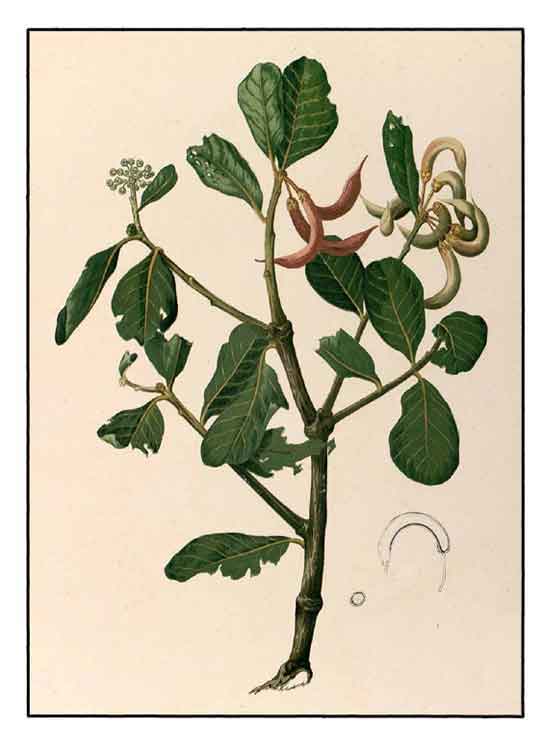 Constituents Constituents
- Phytochemical studies of stems and leaves have yielded amino acids, benzoquinone, tannins, coumarins, flavonoids, saponins, polyphenols, steroids, quinones, phenolic acids, triterpenes, and hydroxyquinone derivatives. (15)
- Stems have yielded 2-methoxy-3-nonylresorcinol, 5-O-ethylembelin, 2-O-acetyl-5-O-methylembelin, 3,7-dihydroxy-2,5-diundecylnaphthoquinone, 2,7-dihydroxy-8-methoxy-3,6-diundecyldibenzofuran-1,4-dione, 2,8-dihydroxy-7-methoxy-3,9-diundecyl dibenzofuran-1,4-dione, 10-hydroxy-4-O-methyl-2,11-diundecyl gomphilactone, 5-O-methylembelin, 3-undecylresorcinol, 2-dehydroxy-5-O-methylembelin compounds. (15)
- Study of EtOAc extract yielded nine compounds and identified as falcarindiol (1), p-hydroxyphenethyl anisate (2), phthalic acid, bis (20ethylhexyl) ester (3), 1-hentriacontanol (4), resveratrol (5), 1,5-dihydroxy-3-methoxy-7-methylanthraquinone (6), 1,3,5-trihydroxy-7-methylanthraquinone (7), quercetin (8), and lupeol (9). (see study below)
(17)
- Qualitative phytochemical analysis yielded alkaloids, phenols, flavonoids, tannins, anthraquinones, glycosides, lignins, and sterols. Quantitative analysis revealed high phenolic content in the aqueous extract and high flavonoid content in the methanol extract. (see study below)
(19)
- Study of stem bark isolated a new oleanane triterpene, 16α-hydroxy-13.28-epoxyoleanan-3-one (1) together with protoprimulagenin, aegicerin, embelinone, syringic acid, gallic acid, isorhamnetic and isorhamnetin 3-O-α-L-rhamnofuranosyl-(1-->6)-ß-D-glucopyranoside. (20)
- Chemical investigation of endophytic fungus Emericella sp. (HK-ZJ) isolated from mangrove plant Aegiceras corniculatum led to isolation of six isoindolone derivatives, emerimidine A and B and emeriphenolicins A, and D, and six previously reported compounds names as[ernidine A and B, austin, austinol, dehydroaustin, and acetoxydehydroaustin. (see study below) (21)
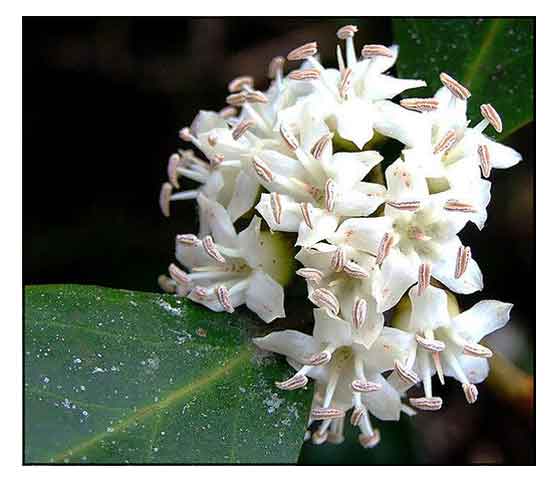 - Six new tetramic acid derivatives, penicillenols A1, A2, B1, B2, Ci, and C2 (1-6), together with citrinin, phenol A acid, phenol A, and dihydrocitrinin, were isolated from Penicillium sp. GQ-7, an endophytic fungus associated with Aegiceras corniculatum. (see study below) (22) - Six new tetramic acid derivatives, penicillenols A1, A2, B1, B2, Ci, and C2 (1-6), together with citrinin, phenol A acid, phenol A, and dihydrocitrinin, were isolated from Penicillium sp. GQ-7, an endophytic fungus associated with Aegiceras corniculatum. (see study below) (22)
GC-MS phytochemical study of leaves identified five compounds: 4,4'-(tetramethylenebisoxy)bis(2-nitro-5-methoxybenzoic acid methyl) ester, Ethyl 2,2-(diethoxyacetate, Pentadecan-4-yl cyclopentanecarboxylate, 2-O-(20methylpropyl) 1-O-pentyl oxalate, and N-(4-nitrobenzilidene)-tert-butylamine. (see study below) (30)
- Study of leaves and stems for fatty acids (FAs) showed the leaves to have more saturated FAs than unsaturated FAs, while the stem showed nearly equal saturated and unsaturated FAs. Major fatty acids in leaves were arachidic acid, heneicosanoic acid, myristoleic acid, linolelaidic acid, linoleic acid, and cis-4,7,11,14,17-eicosapentaenoic acid. Stems yielded major FAs of myristic acid, palmitic acid, linolenic acid, cis-11,14,17-eicosatrienoic acid and arachidonic acids.
(33)
- GC-MS screening of methanolic extract of outer bark of mangrove Aegiceras corniculatum yielded ten bioactive compound, five of which are in higher concentration, namely: 7-Tridecanone, Glycerin, 2 Heptanone-3 methyl alpha-L-Galactopyranoside, methyl 6-deoxy- and 1,6-Anhydro-beta-D-glucopyranase (levoglucosan); five were in lower concentrations: while 2-Furan carboxaldehyde, 5 methyl, 4H-Pyran-4 –one, n-Hexadecanoic acid, Benzene, (2,2-dimethoxyethyl), Hexadecanoic acid methyl ester. (40)
- Study of stems and twigs isolated three new alkylated benzoquinones, 2-hydroxy-5-ethoxy-3-nonyl-1,4-benzoquinone (1), 5-O-butyl-embelin (2), and 2,5-dihydroxy-6-methyl-3-pentadecyl-1,4-benzoquinone (3), along with seven known analogues (4-10). (see study below) (44)
Properties
- Nectar attracts bees.
-
Studies have suggested anticancer, antifungal, antibacterial, antiviral, antiplasmodial, antidiabetic, anti-inflammatory, antioxidant, piscicidal, antinociceptive, hepatoprotective, neuroprotective properties.
Parts used
Fruits, leaves, stem bark, roots.
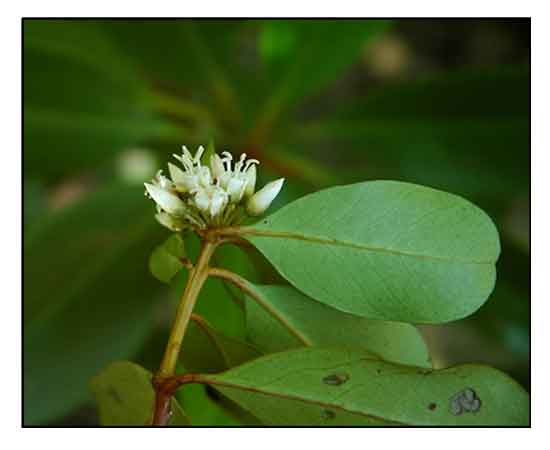 Uses Uses
Edibility
- Leaves are edible; eaten raw or cooked.
Folkloric
- No reported folkloric medicinal use in the Philippines.
- Used for treatment of rheumatism, painful arthritis, and inflammation.
- Fruits, leaves, and stem barks used in traditional medical systems for treatment of asthma, arthritis, diabetes, pain and inflammation, and liver problems.
Others
- Poison: Bark used as fish poison. (also: see study below:
26)
- Wood: Hard and heavy. Used for making knife or tool handles. Also used for fuel and charcoal production.
- Ecology / Agroforestry: A mangrove that contributes to functioning and stability of estuarine and tidal river ecosystems, providing habitat, shelter, and source of food for aquatic and terrestrial organisms, maintenance of water quality (filter and trap sediments and pollutants), soil stability, and foreshore protection. (38)
- Honey: In Bangladesh, khalshi is an important honey producing mangrove species. The species is a potential source of high quality honey and bee-wax from the flowers. (42)
Studies
• Cytotoxicity Against Cancer Cell Lines / Leaves and Roots: Study evaluated 16 Bangladeshi medicinal plants n-hexane, dichlormethane, methanol and water extracts for cytotoxic activity against healthy mouse fibroblasts (NIH3T3) and three human cancer cell lines (gastric AGC, colon HT-29, and breast MDA-MB-435S) using MTT assay. Seven methanolic extracts, including Aegiceras corniculatum, showed low toxicity (IC50 >2.5 mg/mL) against mouse fibroblasts but selective cytotoxicity (IC50 0.2-2.3 mg/mL) against different cancer cell lines. (3)
• Antidiabetic / Leaves: Study evaluated the effect of A. corniculatum leaf extract administered orally via gastric tube on alloxan-induced diabetic rats. Results showed moderate reduction in blood glucose, glycosylated hemoglobin, decrease in activities of glucose-6-phosphatase and fructose 1,6-biphosphatase and increase activity of liver hexokinase. Further studies were suggested for purification of individual compounds and mechanism of action. (4)
• Antiplasmodial Polyherbal Extract / Plasmodium falcifarum / Leaves: Study evaluated the antiplasmodial activity of 13 mangrove plants and 8 seaweed species distributed along the coast of south India. Marine polyherbal preparations from methanolic extracts of two extract showed 63.50 ± 0.408% suppression of parasitaemia against Plasmodium falcifarum . On an invivo rat animal model, the polyherbal extract showed remarkable antiplasmodial activity (50.57 ± 0.465%) against Plasmodium berghei at 120 mg/kbw. Results suggest potential as lead compounds for new antimalarial drugs. (5)
• Antinociceptive / Antidiarrheal / Cytotoxic / Leaves: Study evaluated ethanol extract of leaves of mangrove Aegiceras corniculatum for antinociceptive, antidiarrheal and cytotoxic activities. The extract produced significant writhing inhibition in acetic acid-induced writhing in mice at dose of 250 and 500 mg/kbw (p<0.001) comparable to diclofenac. In castor oil-induced diarrhea testing, there was significantly increased mean latent period and decreased frequency of defecation comparable to drug loperamide. On toxicity testing, the extract showed potent activity against brine shrimp Artemia salina (LC50 10 mg/mL). (6)
• Antioxidant / Anti-Inflammatory / Hepatoprotective / Stems: Study evaluated antioxidant, anti-inflammatory and hepatoprotective potential of A. corniculatum stems. The n-hexane, ethyl acetate and methanol extracts of A. corniculatum stems scavenged superoxide anions, hydroxyl radicals in nitro blue tetrazolium reduction and deoxyribose degradation assays. All extracts inhibited lipid peroxidation at its initiation step. Extracts also significantly protected the carbon tetrachloride (CCl4)-induced oxidative injury in rat liver. The pronounced antioxidant effect may be at least in part related to its anti-inflammatory and hepatoprotective activities. (7)
• Cytotoxicity Against Cancer Cell Lines / Fruit: Study evaluated the cytotoxic activity of 23 crude methanol extracts from 19 Bangldeshi medicinal plants against healthy mouse fibroblasts (NIH3T3), healthy monkey kidney (VERO) and four human cancer cell lines (gastric, AGS; colon, HT-29; breast, MCF-7 and MDA-MB-231) using MTT assay. High cytotoxicity across all cell lines tested was exhibited by Aegiceras corniculatum fruit with IC50 values from 0.0005 to 0.9980 mg/mL. (8)
• Anti-Inflammatory and Melanoma Cytotoxic Compounds: Study isolated secondary metabolites and determined biological activity of chemical constituents isolated from A. corniculatum. Target compounds 2 and 3 were potent inhibitors of cytokines TNF-α, IL-6, and IL-12 p40, indicating promising anti-inflammatory effects. Compounds 1 and 4 strongly promoted apoptosis of B16 F10 melanoma cells. Saponins from A. corniculatum can be potential candidates for treating cancer and inflammatory illnesses. (9)
• Antibacterial Endophytic Fungi / Leaves: Study isolated, characterized and assessed the anti-multiple drug resistant (MDR) bacterial potential of culturable endophytes from A. corniculatum. Antibacterial activity was assayed using five human pathogenic bacteria (B. cereus, P. aeruginosa, E. coli. K. pneumonia, and A. baumanii), two of which were MDR bacteria. Of 61 endophytes obtained from A. corniculatum, Colletrotrichum and Pestalotiopsis were the most frequent genera, with 29.5% and 37.7% colonization frequencies. Three endophytes, Glomerella, Guignardia and Cladosporium, all isolated from leaves showed inhibitory activity against five test bacteria in vitro. Study demonstrates endophytes from mangrove plant A. corniculatum were a fascinating fungal reservoir against MDR pathogenic bacteria. (10)
• Antinociceptive / Stems: Study evaluated various extracts of A. corniculatum stems using various nociceptive models induced chemically or thermally in mice including acetic acid-induced writhing, formalin-induced pawlicking and hot plate test. Results suggest A. corniculatum extracts possess analgesic properties via action on the central nervous system. (11)
• Apoptosis Effect on Human Colorectal Cancer / Leaves: Study evaluated the effects of an n-butanol extract of A. corniculatum leaves on colorectal cancer in vitro and in vivo. Results showed inhibition of viability and proliferation of colorectal cells in a dose dependent manner. The extract also induced cell apoptosis and cell cycle arrest by activating Forkhead box proteins and controlled the cell cycle checkpoint pathways, which are associated with the caspase-dependent mitochondrial apoptotic cascades and Bcl-2 proteins. In vivo, there was decrease in tumor sizes of HT-29 xenograft nude mice.
Results suggested potent anticancer activities in different colorectal and other solid tumor cell lines, via regulation of cell cycle and apoptosis.
(12)
• Anti-Inflammatory Activity / Mechanisms / Stems: Study evaluated the anti-inflammatory potential of A. corniculatum stem extracts and the mechanism of action against various pro-inflammatory mediators using rat paw edema and peritonitis models for in vivo studies and human platelets and rat neutrophils for in vitro studies. A methanol extract caused 90% reduction in the carrageenan- and prostaglandin E2-induced paw edema in rats. There was inhibition of COX-1 metabolite, 12-HHT with a rise in 12-lipoxygenase metabolite, 12-HETE in A23187 stimulated human platelets. Anti-inflammatory effect of hexane and EA extracts was suggested by diminution of carrageenan-induced cell infiltration in rat peritoneum. Extracts caused about 60% suppression in dextran-induced paw edema suggesting amelioration of histamine and serotonin release. (13)
• Anti-Periodontopathogenic Activity / Herbal-Based Mouthwash / Leaves: Study investigated the active compound from Indonesian mangrove leaf extract for developing a herbal-based mouthwash through in silico and in vitro studies. The extract yielded alkaloid, saponin, flavonoid, triterpenoid, steroid, tannin, and quinone. The extract yielded high concentration of (-)epicatechin and coumaric acid. Results showed antioxidant, anti-inflammatory, and antibacterial activities that can potential source of raw material for developing a herbal-based mouthwash. (14)
• Embelin: Embelin is a novel XIAP inhibitor with various medicinal effects including anti-inflammatory and anticancer activities. It induces apoptosis in human glioma cells through inactivation of NF-kB, which is a crucial transcription factor associated with several human diseases including cancer and controls genes involved in tumor progression such as cell proliferation and cell survival. Study reports on the fast, simple, precise, specific, and accurate HPTLC method for the repeatable and selective determination of embelin from A. corniculatum. (15)
• Antituberculosis / Antibacterial / Antioxidant / Leaves: Study evaluated the activity of a leaf extract against Mycobacteria and other microorganisms. Microwave assisted extraction was considered the best in terms of yield, total phenolic and flavonoid content as well as antituberculosis activity. An ethyl acetate fraction showed best activity of 6.25 µg/ml along with highest TPC and antioxidant capacity. There was a positive correlation between antioxidant potential and antituberculosis activity. HPLC chromatogram of microwave crude extract revealed the presence of gallic acid. The plant showed selective inhibition of Mtb and very less cytotoxicity against mammalian cell line. (16)
• PTP1B Inhibitory Activity: Study of EtOAc extract of Aegiceras corniculatum yielded nine compounds. Compound 1, Falcarindiol, showed inhibitory activity towards PTP1B with IC50 value of 9.15 ± 2.48 µmol/L. PTP1B is Protein Tyrosine Phosphatase 1B, which regulates multiple mechanisms implicated in the pathogenesis of Alzheimer's disease (AD). (see constituents above) (17)
• Antioxidant / Leaves and Bark: Study evaluated the antioxidant activities of dried powdered leaves and bark of Aegiceras corniculatum using DPPH, ABTS, and hydrogen peroxide radical scavenging activity, phosphorescence reduction assay, ferric reducing antioxidant power, along with estimation of phenolic, flavonoids, and flavanols. The methanolic and ethyl acetate extracts showed highest antioxidant capacity except in H2O2 scavenging assay. The methanolic extract showed high phenolic content, which strongly correlated with antioxidant activity. (18)
• Neuroprotective / Anti-Inflammatory / Antioxidant / Leaves: Study evaluated the neuroprotective, antioxidant, and anti-inflammatory potential of A. corniculatum. All extracts showed antioxidant activity through various assays. The methanol extract showed significant anti-inflammatory activity with 85.32 percentage inhibition of protein degradation. Methanol extract at 5 µg showed comparatively significant neuroprotection against trimethyltin (TMT)-induced toxicity with 70.02% SK-S-NH cell survival against 56.30% cell survival TMT-intoxicated group. Results showed leaf extracts of AC possess antioxidant, anti-inflammatory and neuroprotective properties. (19)
• Antiviral Isoindolone from Endophytic Fungus: Chemical investigation of endophytic fungus Emericella sp. (HK-ZJ) isolated from mangrove plant Aegiceras corniculatum led to isolation of six isoindolone derivatives, emerimidine A and B and emeriphenolicins A, and D, and six previously reported compounds. Compounds 1 and 2 showed moderate antiviral activity against influenza A virus (H1N1). (see constituents above) (21)
• Cytotoxicity of Endophytic Fungus / Penicillenols: Study isolated new tetramic acid derivatives, penicillenols A1, A2, B1, B2, Ci, and C2 (1-6), together with citrinin, phenol A acid, phenol A, and dihydrocitrinin from Penicillium sp. GQ-7, an endophytic fungus associated with Aegiceras corniculatum. Penicillenols A1 and B1 showed cytotoxicities against HL-60 cell line with IC50s of 0.76 µM and 3.20 µM, respectively. (22)
• Cytotoxic Triterpene Saponins against Cancer Cell Lines / Leaves: Study of leaves isolated 16 compounds, including one new triterpene saponin, aegicoroside A. The isolated compounds were tested against four cancer cell lines: MCF7 (breast), HCT116 (colon), B16F10 (melanoma), and A549 (adenocarcinoma). Compound 2, sakurasosaponin, exhibited strong cytotoxicity against all four cancer cell lines; and sakurasosaponin methyl ester (3) against MCF7. A549 and HCT116 cell lines with IC50s ranging from 2.89 to 9.86 µM. (23)
• Anticoagulant / Antioxidant / Anti-Inflammatory / Bark: Study investigated the antioxidant, anti-inflammatory, and anticoagulation properties of two mangrove plants: Aegiceras corniculatum and Acanthus ilicifolius. A corniculatum bark showed potent antioxidant activity in DPPH assay (IC50 20.49 µg/mL), anti-inflammatory activity in LOX inhibition assay ( IC50 23.58 µg/mL), and anticoagulation activity in prothrombin time assay ( 18.19 min). (24)
• Antifungals / Antibacterial / Acornines / Bark: Mangrove plants are rich sources of secondary metabolites with many beneficial biological activities. Study reports on the isolation of two novel antifungal compounds, Acornine 1 and 2, from the bark of Aegiceras corniculatum. Characterization indicated they are oleanane triterpenoids. Both compounds exhibited growth inhibition of tested Gram positive bacteria. Acornine 2 demonstrated strong antifungal activities against several pathogenic fungi tested. (25)
• Piscicide / Twigs and Stems: Extracts of twigs and stems of mangrove plant Agiceras corniculatum demonstrated toxicity to fish (Tilapia nilotica). 5-O-Methylembelin was isolated and shown to be toxic to fish at concentration of 1 ppm within a period of 75 min. (26)
• Anti-Inflammatory / Antiarthritic / Twigs and Stems: Study evaluated methanol and ethyl acetate extracts from A. corniculatum against chronic inflammation by using cotton pellet induced granuloma and adjuvant induced arthritis models in rats. Vascular permeability and leukocyte migration were also studied. Results showed highly effective reduction of granulomatous tissue formation in a dose dependent manner. Extracts also suppressed paw thickness induced by using adjuvant in rat arthritis model. The EA extract caused 75% inhibition in paw swelling at 200 mg/kg and inhibition in leukocyte migration of 63% at 50 mg/kg against LTB4. Both extracts showed remarkable reduction in acetic acid induced vascular permeability. (27)
• Anthelmintic / Stems: Study evaluated the anthelmintic effect of Aegiceras corniculatum using in vitro properties of four crude extracts (petroleum ether, chloroform, methanol, and aqueous) against earthworm Pheretima posthuma. The four extracts showed dose dependent and significant anthelmintic activities. (28)
• Silver Nanoparticles: Study reports on the bioformulation protocol for synthesis of silver nanoparticles using a mangrove extract of Aegiceras corniculatum. Results showed mangrove-fabricated silver nanoparticles was more biocompatible when compared to synthesized silver NPs, highlighting their promising potential as nanocarriers in pharmacology and nanomedicine. (29)
• Antidiabetic Phytochemicals / In Silico Screeni9ng / Leaves: GC-MS phytochemical study of leaves identified five compounds: 4,4'-(tetramethylenebisoxy)bis(2-nitro-5-methoxybenzoic acid methyl) ester, Ethyl 2,2-(diethoxyacetate, Pentadecan-4-yl cyclopentanecarboxylate, 2-O-(2-methylpropyl) 1-O-pentyl oxalate, and N-(4-nitrobenzilidene)-tert-butylamine. The antidiabetic activity of the 5 compounds was analyzed with molecular docking study against dipeptidyl peptidase IV (DPP-IV). which is found elevated in persons with diabetes. Among the five, 2-O-(2-methylpropyl) 1-O-pentyl oxalate showed maximum score with DPP-IV in molecular docking study and considered the best fit. Results suggest additional cell line and animal testing for antidiabetic studies and an effectual and inexpensive drug because of higher biomass availability of A. corniculatum. (30)
• Pesticidal / Bark: Study evaluated nine different plant parts from five plants, namely: Aegiceras corniculatum, Excoecaria agallocha, Heritiera fomes, Xylocarpus moluccensis, and Xylocarpus granatum, for insecticidal activity against two common stored product pests, Sitophilus oryzae and Sitophilus zeamis. Three bark extracts including A. corniculatum showed potent and statistically significant insecticidal activity against the two pests (80-100% mortality). On fractionation, The SPE4 fractions (100% MeOH) from the three plants showed activity against S. oryzae pest, with LC50 of 0.5 mg/disc for A. corniculatum. On LC-ESI-MS study, the active fraction of A. corniculatum identified isorhamnetin 3-O-rutinoside and paspaline as major constituents. (31)
• Immunomodulatory / Anti-Atherogenic / Bark: Study evaluated the effects of ethyl acetate extracts of A. corniculatum in inhibiting inflammatory responses interfering with diverse cellular and molecular mechanisms including pro-inflammatory prostanoid production, COX and LOX expression, and leukotriene B4 dependent cell migration. Study investigated the effect of the extract against MCP-1 dependent cell migration in vivo, ex vivo and in vitro. Results indicate the EA extract impairs MCP-1 dependent cell migration via cPLA2/iPLA2 signaling pathways, specifically inhibiting sEH signaling molecules. Results suggest potential as an anti-atherogenic agent with unique mechanism against lipid signaling, which is further enhanced by its inhibitory effect against oxidative burst phenomenon via suppression of super oxide anion production in opsonized zymosan-stimulated human neutrophils. (32)
• Anti-Inflammatory / Anti-Atherogenic / Bark: Study evaluated the anti-inflammatory effects of methanol and ethyl acetate extracts from A. corniculatum in carrageenan-induced pleurisy mouse model of acute inflammation. Results showed both extracts at higher doses (100 mg/kg) demonstrated remarkable reduction (about 82%) in leukocytes migration. MPO (myeloperoxidase) and nitrate/nitrite concentrations also showed a dose dependent decline in presence of both extracts reaching a maximum value of 83% at 100 mg/kg, suggesting a protective effect in the management of acute lung inflammation. Results suggest carrageenan administration into the pleural cavity caused accumulation of fluid containing infiltrated PMNs from lung tissues that enhanced production of interleukin-1ß, IL-6, and TNF-α and COX-2, which were likely attenuated by A. corniculatum suggesting its protective effect in acute lung inflammatory conditions. (34)
• Analgesic / Leaves Study evaluated the analgesic activity of methanolic extract of leaves using acetic acid induced writhing method and tail immersion method Extract showed dose dependent analgesic activity with acetic acid writhing test with gradual decrease in the number of writhes as the concentration increased, while tail immersion method showed longer capability of withstanding of pain when kept in water bath. (35)
• Antioxidant: Study evaluated the antioxidant potent of different parts of A. corniculatum along with comparative assessment between crude extracts and purified embelin isolates. Results showed crude extracts and embelin showed better antioxidant potency particularly in fruit, followed by root, stem bark and leaf. Crude extracts were found superior to purified isolates in terms of antioxidant potency. Both crude formulation and purified compounds have potential for use in drug formulation industries. (39)
• Anti-Arthritic / Anti-Inflammatory: Study evaluated methanol and ethyl acetate extracts of A. corniculatum against chronic inflammation using cotton pellet induced granuloma and Adjuvant induced arthritis model in rats. In cotton pellet granuloma, the extracts were highly effective in reducing granulomatous tissue formation in a dose-dependent manner and suppressed paw thickness induced by adjuvant in rat arthritis model. The EA extract showed inhibition in leukocytes migration (63% at 50 mg/kg) against KTB4 and carrageenan. Both extracts showed remarkable reduction in acetic acid induced vascular permeability. Results suggest remarkable effect as an anti-arthritic and anti-inflammatory against chronic inflammatory diseases, providing justification for its folkloric use against rheumatism. (41)
• Mangrove Regeneration: Study reports on the development of nursery and plantation technique for regeneration and popularization of Aegiceras corniculatum in the Sundarban of Bangladesh. The experiments include planting method, time and qualities of seedlings in different salinity zone in the study of sylvicultural technologies. Study suggests generated benefits i.e., direct economic and ecological benefits to coastal communities, and the inclusion of mangrove areas in marine and coastal protective areas. (42)
• Palmitic Acid / Antibacterial Fatty Acid: Study evaluated the antibacterial effects of fatty acids (FAs) from leaf, stem, flower, and pneumatophore of Aegiceras corniculatum against human pathogens viz., Escherichia coli, Klebsiella pneumonia, Pseudomonas aeruginosa and Staphylococcus aureus. FAs were isolated as fatty acid methyl esters using GC-FID. Palmitic acid (C16:0) was the chief constituent in crude extracts of leaf, stem, and flower. Methyl-cis-5,8,11,14-eicosotetranoic acid (PUFA, C20:4) was found dominant in pneumatophore. The FAs showed significant activity against Gram(-) K. pneumonia and moderate activity against Gram(+) S. aureus. Study suggests evaluation for use in synergistic combinations with antimicrobials already in use. (43)
• Anticancer / Alkylated Benzoquinone / Stems and Twigs: Study of stems and twigs isolated three new alkylated benzoquinones, 2-hydroxy-5-ethoxy-3-nonyl-1,4-benzoquinone (1), 5-O-butyl-embelin (2), and 2,5-dihydroxy-6-methyl-3-pentadecyl-1,4-benzoquinone (3), along with seven known analogues (4-10). MTT assay for cytotoxic activities of isolated compounds showed compounds 1, 2, 8, 9, and 10 possess varying degrees of selective cytotoxicity against HL-60, HepG2, BGC-823, and A2780 cell lines. (44)
Availability
Wild-crafted. |

![]()



 Gen info
Gen info
 Constituents
Constituents

